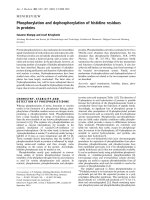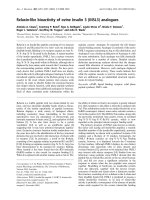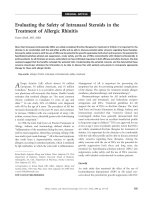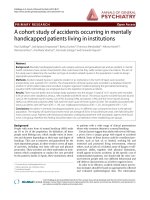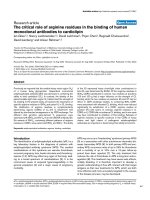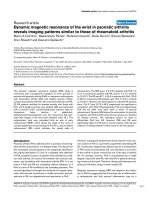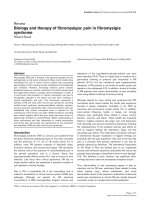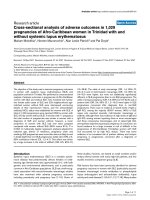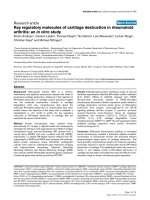Báo cáo y học: "Light-dark cycle synchronization of circadian rhythm in blind primates" doc
Bạn đang xem bản rút gọn của tài liệu. Xem và tải ngay bản đầy đủ của tài liệu tại đây (465.3 KB, 5 trang )
BioMed Central
Page 1 of 5
(page number not for citation purposes)
Journal of Circadian Rhythms
Open Access
Short paper
Light-dark cycle synchronization of circadian rhythm in blind
primates
Mayara MA Silva, Alex M Albuquerque and John F Araujo*
Address: Laboratório de Cronobiologia, Departamento de Fisiologia, CB/UFRN, Natal, Brazil
Email: Mayara MA Silva - ; Alex M Albuquerque - ; John F Araujo* -
* Corresponding author
Abstract
Background: Recently, several papers have shown that a small subset of retinal ganglion cells
(RGCs), which project to the suprachiasmatic nucleus (SCN) and contain a new photopigment
called melanopsin, are the photoreceptors involved in light-dark entrainment in rodents. In our
primate colony, we found a couple of common marmosets (Callithrix jacchus) that had developed
progressive and spontaneous visual deficiency, most likely because of retinal degeneration of cones
and/or rods. In this study, we evaluated the photoresponsiveness of the circadian system of these
blind marmosets.
Methods: Two blind and two normal marmosets were kept in cages with a controlled light-dark
cycle (LD) to study photoentrainment, masking, and phase response to a dark pulse.
Results: Blind marmosets were entrained with the new LD cycle when light onsets were delayed
and advanced by 6 hours. In constant light conditions, blind marmosets free-ran with a period of
23.2 hours, while normal animals free-ran with a period of 23.6 hours. All marmosets responded
to dark pulses in the early subjective day with phase delays and with phase advances in the late
subjective day.
Conclusion: Our results demonstrate that light can synchronize circadian rhythms of blind
marmosets and consequently, that this species could be a good primate model for circadian
photoreception studies.
Introduction
In mammals, circadian rhythms of physiological and
behavioral variables are driven by a master circadian pace-
maker, the suprachiasmatic nucleus (SCN). To be useful,
the circadian clock must be synchronized to the light and
dark alternation of the real world's day-night cycles. In
mammals, the eyes are required for photoentrainment.
Because only rods and cones were known to be ocular
photoreceptors, it was generally assumed that circadian
photoreception relied on these cells. However, studies on
rd/rd mice, which lack rod photoreceptors, and more
recent studies on rd/rd cl mice, which lack all functional
rods and cones, have provided overwhelming evidence
that these classical photoreceptors are not required for
photoentrainment [1,2]. Recently, several papers have
shown that a small subset of retinal ganglion cells (RGCs)
that project to the SCN and contain a new photopigment
called melanopsin serve as photoreceptors involved in
light-dark entrainment in rodents [3-7]. Melanopsin was
also found in humans, other primates, rats, and mice [8].
Published: 06 September 2005
Journal of Circadian Rhythms 2005, 3:10 doi:10.1186/1740-3391-3-10
Received: 17 August 2005
Accepted: 06 September 2005
This article is available from: />© 2005 Silva et al; licensee BioMed Central Ltd.
This is an Open Access article distributed under the terms of the Creative Commons Attribution License ( />),
which permits unrestricted use, distribution, and reproduction in any medium, provided the original work is properly cited.
Journal of Circadian Rhythms 2005, 3:10 />Page 2 of 5
(page number not for citation purposes)
Several studies have shown that the melanopsin photore-
ceptors not only regulate the circadian system, but also
contribute to both papillary light reflex and acute altera-
tions in motor activity, and may be involved in a broad
range of physiological and behavioral responses to light
[8].
The common marmoset (Callithrix jacchus) is a small neo-
tropical primate found in the northeast of Brazil and is
easily adapted to laboratory use. It is a diurnal animal and
has a bimodal circadian pattern. The motor activity of
these animals displays a stable circadian rhythm in con-
stant light. Light pulses cause delays when given in the
early subjective night and phase advances when given in
the late subjective night [9,10]. Studies of morphology of
retinal ganglion cells in marmosets have shown a sex-
linked polymorphism of cone pigment expression, such
that all males are dichromats and the majority of females
are trichromats [11].
In our primate colony, we found a couple of common
marmosets that had developed progressive and spontane-
ous visual deficiency. They were living in semi-natural
conditions and were active during the day and inactive at
night. Ophthalmoscopic examination did not show opac-
ities of the cornea, lens, and vitreous, nor lesions of the
optic nerve, nor vascular retinopathies. The most impor-
tant feature in fundoscopy was a bilateral pigmentation in
the macular region, which is similar to retinal rod degen-
eration. As it is known that ganglion cells are generally
preserved in retinal degeneration disease [12], we pro-
posed that these marmosets have a retinal degeneration of
cones and/or rods. Based on previous studies, we believe
that this retinal degeneration of rods and cones does not
impair expression of circadian rhythmicity, photoentrain-
ment, masking, and phase response to a dark pulse. In
order to test this hypothesis, these marmosets were trans-
ferred to the laboratory so that the light-dependent fea-
tures of their circadian system could be studied.
Methods
Four marmosets (one normal male, one blind male, one
normal female, and one blind female), with an average
age of eight years and average weight of 354 g, were
housed in individual cages in a room with attenuated
noise, controlled temperature (average temperature of
25.5°C), water at libitum and food daily available for 8.5
hours. The animals were first exposed to an LD cycle of 24
hours (LD 12:12). Illuminance was 150 lux during the
light phase and 1 lux during the dark phase. The marmo-
sets were adapted to the laboratory for 10 days. After two
weeks in LD 12:12, the time of lights-on was delayed by 6
hours; three weeks later, it was advanced by 6 hours. Four
weeks later, the marmosets were placed in constant light
conditions for 4 weeks. The marmosets were then
returned to LD 12:12 for 3 more weeks and then again to
constant light for 4 weeks.
General circadian locomotor activity of the marmosets
was measured using an infrared motion sensor above the
cage. Output from the sensors was integrated with an
IBM-compatible computer running data acquisition soft-
ware. Analyses of rhythm characteristics and graphical
output, actograms, were undertaken using the El Temps
computer program (Diez-Noguera, Barcelona, Spain). The
free-running period of the locomotor activity rhythm
under constant light was computed by the chi square per-
iodogram procedure [13] with a global risk level (α) of p
< 0.05. Under LL, the onset of activity, designated as circa-
dian time (CT) 0, was used as the phase reference point for
the onset of the subjective day. Phase-shifts were deter-
mined as the difference between projected times of activ-
ity onset on the day after dark stimulation. The dark
stimulation consisted of 2-hour pulses of darkness. Exper-
iments were in compliance with the institutional guide-
lines of the Universidade Federal do Rio Grande do Norte
and Sociedade Brasileira de Neurociência e
Comportamento.
Results and discussion
The marmosets were submitted to two behavioral tests. In
the first one, a non-smelling object (such as a pen or a
key) was placed two centimeters away from each animal's
face. The normal marmosets directed their sight to the
object and tried to grab and bite it; the blind animals did
not react to the objects at all. The same test was repeated
with the objects in movement, and again only the normal
marmosets reacted by directing their sight to the moving
object. The second test took place in a room with dim
light (10 lux). A spotlight was placed on one side of the
animals and directed to their faces. The normal marmo-
sets turned their faces towards the light, while the blind
ones did not.
As shown in Figure 1, blind marmosets were clearly syn-
chronized to the external cycles. Like normal animals,
blind animals showed a normal biphasic activity circa-
dian rhythm, with a more intense bout of activity at the
beginning of the light phase and a second bout near the
end. However, this bimodal pattern was less prominent in
blind animals (Figure 2). Additionally, blind marmosets
showed a shorter active phase compared to normal ani-
mals. After we shifted the light phase by 6 hours (first a
delay and then an advance), blind marmosets were
entrained to the new light-dark cycle, but their entrain-
ment was much slower compared to the normal marmo-
sets (Figures 1 and 2). The blind animals synchronized
only after 12–14 days, while the normal animals did so
after 3–4 days. During entrainment, the phase angle of
Journal of Circadian Rhythms 2005, 3:10 />Page 3 of 5
(page number not for citation purposes)
activity onset in relation to the LD cycle was different in
blind and normal marmosets (see Figure 2).
The animals were then placed in constant light conditions
in order to determine if they had functional circadian
clocks. As show in Figure 1, the marmosets showed free-
running circadian rhythms. Free-running periods were sig-
nificantly different between the two groups: blind mar-
mosets showed a 23.2-hour period while normal
marmosets free-ran showed a period of 23.6 hours. This
shorter period in blind marmosets could be explained by
their lower activity and, consequently, decreased motor
activity feedback to the circadian system, or by the partic-
ipation of classical photoreceptors (rods and cones) in the
generation of free-running circadian rhythms. However, it
could also be explained by the suggestion that the loss of
rods and cones has an impact on the nature of light infor-
mation reaching the SCN [8].
For photic entrainment to occur, the circadian oscillator
must respond differently to light at different phases of its
cycle. Phase response curves (PRC) are useful descriptions
of these phase-dependent responses. A number of non-
photic stimuli, both pharmacological and non-pharmaco-
logical, have been identified as able to induce phase shifts
in mammalian circadian clocks as a function of the circa-
dian phase that the stimulus is presented [14]. The PRC of
non-photic stimuli (including dark pulses presented to
animals kept in constant light) is 180° out of phase with
photic stimuli. We tested the phase-shift response of blind
marmosets using dark pulses of 2-hour duration. When
the dark pulse was given in the early subjective day, it
caused a phase delay; when given in the late subjective
day, it caused a phase advance. This result is an important
contribution to the discussion about the non-photic
phase shift in this species. Our results agree with Glass et
al [14], in whose studies the qualitative similarities
between the phase responses to entraining photic and
non-photic stimuli in marmosets and nocturnal mam-
mals were demonstrated.
Many of the non-photic stimuli that induce phase shifts in
the circadian clocks also induce an acute increase in loco-
motor activity in nocturnal mammals, and it appears that
at least some of the phase shifting effects of these agents is
due to the induction of activity and/or arousal [15]. In the
present study in marmosets, the phase shifts produced by
dark pulses were not due to the inhibition of activity. The
dark pulses produced an inhibition of activity (negative
masking) in the sighted marmosets but not in the blind
ones, despite the fact that both groups showed phase
shifts with dark pulses.
The response of the circadian system to different stimuli,
photic and non-photic, is of great importance because
implies that circadian systems are in fact able to use many
sources of information. As the marmoset is a social ani-
mal, we also investigated social synchronization between
these animals. Blind marmosets showed different activity
onset during the free-running phase, but they showed a
stable phase angle. The two normal marmosets showed
the same behavior but with different free-running periods
from the blind marmosets. Therefore, despite the fact that
the four animals were in the same room, the blind mar-
mosets were not synchronized with the normal ones.
One limitation of this study is the small number of ani-
mals, but the results of the two normal marmosets are
similar to other studies that were conducted in our labo-
ratory [16]. Considering studies previously carried out in
Light-dark cycle synchronization of circadian rhythms in blind primatesFigure 1
Light-dark cycle synchronization of circadian
rhythms in blind primates. Shown are representative
double-plotted motor activity records of a blind marmoset
during photoentrainment, advance and delay of light phase,
and free-run in constant light condition (LL). Time is indi-
cated at the bottom, day at left side, and the light-dark cycle
(LD) or LL on the right side. The boxes represent the light
phase of the LD cycle.
Journal of Circadian Rhythms 2005, 3:10 />Page 4 of 5
(page number not for citation purposes)
rodents along with our present results, it is possible to
infer that the blind marmosets had normal retinal gan-
glion cells, which are required to synchronize their circa-
dian clocks to the LD cycle. In the absence of classical
photoreceptors, photosensitive ganglion cells are suffi-
cient for photic entrainment [17].
Conclusion
Ours results constitute the first experimental evidence that
non-classical retinal photoreceptors can provide photic
information to the circadian system of primates and diur-
nal animals. The blind marmosets may provide an excel-
lent model for the study of photoreception and
entrainment in primates. Possible benefits are obvious,
such as the development of strategies to solve the problem
of synchronization in blind humans or to study retinal
degeneration.
Competing interests
The author(s) declare that they have no competing
interests.
Authors' contributions
MMAS: Participated in all experiments, in the analysis and
discussion of the results, and in the writing of the
manuscript.
AMA: Participated in all experiments, in the analysis and
discussion of the results, and in the writing of the
manuscript.
JFA: Participated in all experiments, in the analysis and
discussion of the results, and in the writing of the
manuscript.
All authors read and approved the final manuscript.
Acknowledgements
We thank Dr. Alexandre Bezerra Gomes for performing the ophthalmo-
scopic exam in our animals. Supported by grants from CNPq (to JFA and
MMAS) and PPq-UFRN (to AMA).
References
1. Foster RG: Keeping an eye on the time: the Cogan Lecture.
Invest Ophth Vis Sci 2002, 43:1286-1298.
Circadian pattern of motor activity in blind and normal marmosetFigure 2
Circadian pattern of motor activity in blind and normal marmoset. (A) Representative double-plotted motor activity
of a blind (left) and a normal (right) animal. (B) Wave form plot of activity of blind (left) and normal (right) marmoset. Both ani-
mals showed a bimodal pattern of activity, but this bimodal pattern was less prominent in the blind animal, which showed a
shorter active phase compared to the normal animal. (C) Periodogram of activity rhythms for blind (left) and normal (right)
marmoset in the LD cycle. (D) Entrainment of the blind marmoset after the time of lights-on was delayed by 6 hours. (E)
Entrainment of the sighted marmoset after the time of lights-on was delayed by 6 hours.
Publish with BioMed Central and every
scientist can read your work free of charge
"BioMed Central will be the most significant development for
disseminating the results of biomedical research in our lifetime."
Sir Paul Nurse, Cancer Research UK
Your research papers will be:
available free of charge to the entire biomedical community
peer reviewed and published immediately upon acceptance
cited in PubMed and archived on PubMed Central
yours — you keep the copyright
Submit your manuscript here:
/>BioMedcentral
Journal of Circadian Rhythms 2005, 3:10 />Page 5 of 5
(page number not for citation purposes)
2. Lucas RJ, Douglas RH, Foster RG: Characterization of an ocular
photopigment capable of driving pupillary constriction in
mice. Nature Neurosci 2001, 4:621-625.
3. Berson DM, Dunn FA, Takao M: Phototransduction by retinal
ganglionar cells that set the circadian clock. Science 2002,
295:1070-1073.
4. Provencio I, Rollag MD, Castrucci AM: Photoreceptive net in the
mammalian retina. This mesh of cells may explain how some
blind mice can still tell day from night. Nature 2002, 415:493.
5. Ruby NF, Brennan TJ, Xie X, Cao V, Franken P, Heller HC, O'Hara
BF: Role of melanopsin in circadian responses to light. Science
2002, 298:2211-2213.
6. Hattar S, Liao HW, Takao M, Berson MD, Yau KW: Melanopsin-
containing retinal ganglion cells: architecture, projections,
and intrinsic photosensitivity. Science 2002, 295:1065-1070.
7. Lucas RJ, Hattar S, Takao M, Berson MD, Foster RG, Yau KW:
Diminished pupillary reflex at high irradiances in melanop-
sin-knockout mice. Science 2003, 299:245-247.
8. Foster RG, Hankins M, Lucas RJ, Jenkins A, Muñoz M, Thompson S,
Appleford JM, Bellingham J: Non-rod, non-cone photoreception
in rodents and teleost fish. Molecular clocks and light signal.
Novartis Found Symp 2003, 253:3-30.
9. Erket HG: Characteristics of the circadian activity rhythm in
common marmoset (Callithrix j. jacchus). Am J Primatol 1989,
17:271-286.
10. Wechselberger E, Erkert HG: Characteristics of the light-
induced phase response of circadian activity rhythms in com-
mon marmoset, Callithrix j. jacchus (Primates Cebidae).
Chronobiol Int 1994, 11:275-284.
11. Ghosh KK, Goodchild AK, Sefton AE, Martin PR: Morphology of
retinal cells in new world monkey, the marmoset Callithrix
jacchus. J Comp Neurol 1996, 366:76-92.
12. Chierzi S, Cenni MC, Maffei L, Pizzorusso T, Porciatti V, Ratto GM,
Strettoi P: Protection of retinal ganglionar cells and preserva-
tion of function after optic nerve lesion in bcl-2 transgenic
mice. Vision Res 1998, 38:1537-1543.
13. Sokolove PG, Bushell WN: The chi square periodogram: its util-
ity for analysis of circadian rhythms. J Theor Biol 1978,
72:131-160.
14. Glass JD, Tardif SD, Clements R, Mrosovsky N: Photic and
nophotic circadian phase resenting in a diurnal primate, the
common marmoset. Am J Physiol 2001, 280:R191-R197.
15. Mrosovsky N: Locomotor activity and nonphotic influences on
circadian clocks. Biol Ver Camb Philos Soc 1996, 71:343-372.
16. Mendes ALB: Influência de pistas sociais sobre a sincronização
do ritmo circadiano de atividade motora no sagui, Callithrix
jacchus, ao ciclo claro-escuro. In Master Thesis Psychobiology
Graduate Program, UFRN; 2003.
17. Mrosovsky N: Contribution of classic photoreceptors to
entrainment. J Comp Physiol [A] 2003, 189:69-73.

